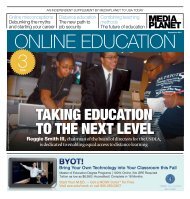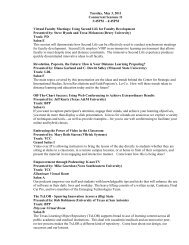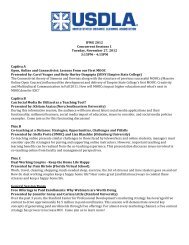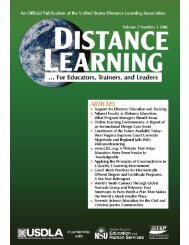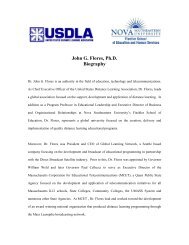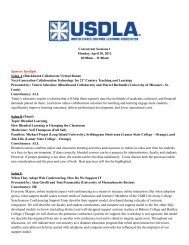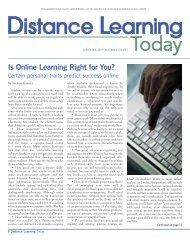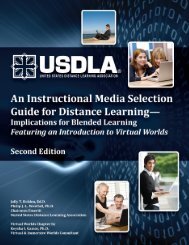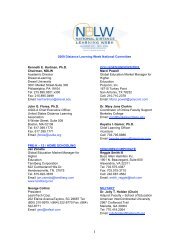United States Distance Learning Association
United States Distance Learning Association
United States Distance Learning Association
- No tags were found...
Create successful ePaper yourself
Turn your PDF publications into a flip-book with our unique Google optimized e-Paper software.
Education is a vital element of society.<br />
Individuals have two choices: adapt, or<br />
risk being replaced. In today’s knowledge<br />
economy, individuals not only have to<br />
obtain the necessary foundation skills and<br />
keep them current; they also need to<br />
acquire new knowledge and skills if they<br />
wish to maintain their status quo. The fastevolving<br />
pace of today’s business environment<br />
demands that its workers become<br />
lifelong learners. Tuijnmam (2003) defines<br />
lifelong learning as the process of individual<br />
learning across a person’s life span,<br />
from cradle to grave. Lifelong learning can<br />
occur in both a formal and an informal setting.<br />
A formal setting is provided by an<br />
educational institution. This is not only<br />
true for information technology professionals,<br />
but also for those who are expected<br />
to interact with the electronic and fully<br />
automated information systems available<br />
in one way or another (Richards & Garcia,<br />
2006). For example, accountants and<br />
finance professionals must understand<br />
how information systems enable real-time<br />
information to make decisions regarding<br />
the productive use of the company’s<br />
resources (Richards & Garcia, 2006). The<br />
need for education has expanded remarkably.<br />
Unfortunately, more often than not,<br />
these needs are at odds with the lack of<br />
time to pursue such endeavors. Today’s<br />
workers and their sponsors expect ondemand<br />
learning services (Mariasingarn,<br />
2005).<br />
However, working professionals are not<br />
the only ones demanding online learning.<br />
Younger generations which have grown<br />
accustomed to technology expect to be<br />
exposed to the same level of technology in<br />
school as they do for entertainment. The<br />
digital divide so pervasive among baby<br />
boomers is not an issue for them.<br />
ADMINISTRATION<br />
Administrators at many institutions of<br />
higher education believe that delivering<br />
distance education costs less than traditional<br />
education. Moved by this belief, they<br />
invest heavily in new technologies. However,<br />
the cost of investing in expensive,<br />
cutting-edge technology requires a critical<br />
mass in order to be effective. A study of<br />
various methods of course delivery conducted<br />
by Neely (2004) revealed that the<br />
number of students enrolled in a course<br />
has a significant effect on the unit cost of a<br />
course per student. Thus, consistently running<br />
small classes will increase the time it<br />
takes the institution to amortize the initial<br />
investment in new technologies. In those<br />
cases, the total cost for face-to-face courses<br />
tends to be lower than for technologydelivered<br />
courses.<br />
A common mistake when measuring<br />
quality in distance education is to equate<br />
success with increased enrollments. Quantity<br />
is not quality (Ström, 2004; U.S.<br />
National Commission on Libraries and<br />
Information Science, 2001). Concentrating<br />
on quantity will inevitably lead to commoditization<br />
of the education provided. If<br />
commoditization occurs, competition will<br />
focus on price, not on quality, which will<br />
undoubtedly have devastating consequences<br />
for those institutions that don’t<br />
operate at the lowest cost in the market<br />
(Weigel, 2000).<br />
Hemlata (2005) asserts that the four<br />
main issues encountered by administrators<br />
when implementing online education at<br />
their institution are sustainability, quality,<br />
organization, and learner support system.<br />
Administrators seem to agree to a systematic<br />
approach to online learning, one that<br />
must begin with a careful analysis and further<br />
strengthening of the mission statement<br />
of the organization (Hemlata, 2005).<br />
A major risk in distance education<br />
endeavors is the tendency of some institutions<br />
to hire cheaper labor to reduce costs<br />
(Twigg, 2001a). Excessive use of teaching<br />
assistants and adjuncts may solve a problem<br />
in the short run, but the long-term cost<br />
in quality could be greater than what the<br />
institution might anticipate (American<br />
Federation of Teachers, 2000). First, the<br />
24 <strong>Distance</strong> <strong>Learning</strong> Volume 4, Issue 4



